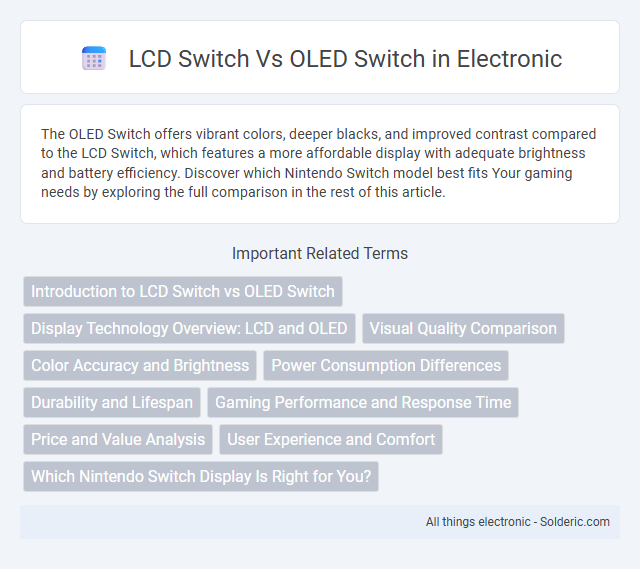The OLED Switch offers vibrant colors, deeper blacks, and improved contrast compared to the LCD Switch, which features a more affordable display with adequate brightness and battery efficiency. Discover which Nintendo Switch model best fits Your gaming needs by exploring the full comparison in the rest of this article.
Comparison Table
| Feature | LCD Switch | OLED Switch |
|---|---|---|
| Display Technology | Liquid Crystal Display | Organic Light Emitting Diode |
| Screen Quality | Good brightness, decent color accuracy | Superior color vibrancy and contrast |
| Power Consumption | Higher power usage | Lower power usage, more energy-efficient |
| Black Levels | Limited, backlight leakage | True blacks, no backlight |
| Screen Durability | More resistant to burn-in | Prone to burn-in over extended use |
| Cost | Generally lower price | Higher cost |
| Battery Life Impact | Shorter battery life due to backlight | Longer battery life due to energy efficiency |
| Viewing Angles | Moderate, color shifts at angles | Wide viewing angles, consistent colors |
Introduction to LCD Switch vs OLED Switch
The Nintendo Switch offers two main display types: the original LCD model and the OLED model, each with distinct visual characteristics. The OLED Switch features a 7-inch OLED screen that delivers deeper blacks, higher contrast, and more vibrant colors compared to the 6.2-inch LCD screen on the original Switch. Enhanced display technology in the OLED Switch provides an improved gaming experience, especially in darker scenes and high-contrast visuals.
Display Technology Overview: LCD and OLED
LCD display technology uses a backlight to illuminate pixels made of liquid crystals, offering reliable brightness and color accuracy with lower power consumption, while OLED displays feature self-emissive pixels that provide deeper blacks, higher contrast, and faster response times. Your choice between an LCD switch and an OLED switch impacts visual clarity and battery efficiency, as OLED screens tend to consume more power but deliver superior image quality. Understanding these differences can help you select the best display technology for your gaming needs.
Visual Quality Comparison
OLED Switch delivers superior visual quality with deeper blacks, higher contrast ratios, and more vibrant colors compared to the LCD Switch, which relies on backlighting that can cause light bleed and less accurate color reproduction. The OLED display offers faster response times, reducing motion blur and enhancing gameplay clarity, especially in fast-paced scenes. Users seeking immersive and vivid visuals benefit significantly from the OLED technology's improved brightness and viewing angles over the LCD counterpart.
Color Accuracy and Brightness
OLED Switch offers superior color accuracy with deeper blacks and more vibrant colors compared to the LCD Switch, which may display slight color washout due to backlighting limitations. OLED technology achieves higher contrast ratios and brightness at localized pixels, enhancing visual clarity in dark scenes, whereas the LCD Switch relies on uniform backlighting that can reduce overall brightness and contrast. For gamers prioritizing rich color fidelity and sharp image quality, the OLED Switch provides a more immersive visual experience.
Power Consumption Differences
OLED Switch displays consume less power than LCD Switch models because OLED technology lights individual pixels, allowing black or dark areas to remain off, significantly reducing energy use. LCD Switch screens require a constant backlight, which increases power consumption regardless of the displayed content. Consequently, OLED Switch offers better battery efficiency, especially during gameplay with darker visuals.
Durability and Lifespan
OLED Switch screens offer vibrant colors and deeper blacks but are more prone to burn-in and generally have a shorter lifespan compared to LCD Switch screens. LCDs use a backlight, making them less susceptible to image retention and often more durable under heavy usage. For your long-term gaming experience, an LCD Switch may provide greater durability and longevity.
Gaming Performance and Response Time
OLED switches provide superior gaming performance and faster response times compared to LCD switches due to their self-illuminating pixels, which deliver deeper blacks and higher contrast. This leads to smoother visuals and reduced motion blur, enhancing your overall gaming experience. While LCD switches may offer lower prices, OLED panels are favored for their quicker pixel response and more vibrant colors that benefit fast-paced gameplay.
Price and Value Analysis
The Nintendo Switch with an LCD screen typically offers a lower price point, making it a more budget-friendly option for gamers seeking solid performance without extra cost. OLED Switch models provide enhanced value through vibrant colors and improved contrast, justifying their higher price with superior display quality and better media viewing experiences. Your choice depends on whether you prioritize affordability or premium visuals for your gaming sessions.
User Experience and Comfort
OLED Switch offers deeper contrast and more vibrant colors, enhancing visual clarity and reducing eye strain during extended gaming sessions. LCD Switch provides consistent brightness and is generally more affordable, making it suitable for users prioritizing durability and budget. Your comfort depends on whether you prefer vivid visuals with better black levels from OLED or the reliable performance of LCD screens.
Which Nintendo Switch Display Is Right for You?
The Nintendo Switch OLED features a 7-inch OLED screen offering vibrant colors and deeper blacks, ideal for users prioritizing superior visual quality and enhanced handheld gaming experiences. The original Nintendo Switch has a 6.2-inch LCD screen that provides good brightness and battery efficiency, suitable for players who want a budget-friendly option with reliable performance. Choosing between the OLED and LCD models depends on your preference for display quality versus cost and battery life.
LCD switch vs OLED switch Infographic

 solderic.com
solderic.com